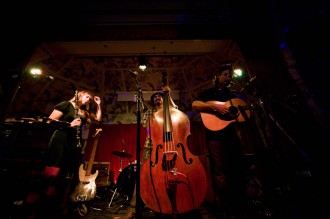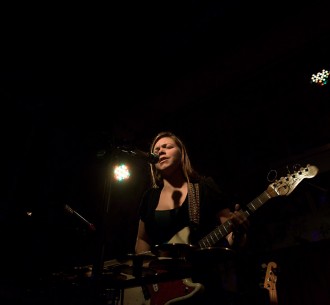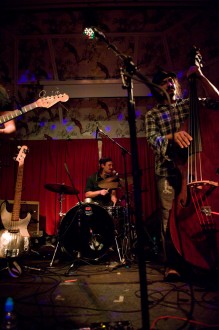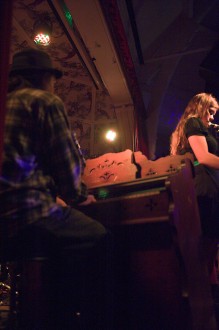The Low Anthem Story So Far
However, as Miller reveals, The Low Anthem clearly likes to over-think and to obsess, in the process creating work that, conversely, seems natural and effortless in its execution. Miller admits, “We fussed and scraped for every sound on the record. We didn’t just throw up some mikes and get lucky. Everything was fought for. We would do about 20 takes minimum of every song. We tried to keep everything on the table as far as how the songs would be arranged. A song might start out as a sweet, lilting folk tune and wind up with a Pogues-like rock sound. ‘The Horizon Is a Beltway’ started out as a little ditty in three on a pump organ, very pretty, but we didn’t get the energy back from the song that way. Likewise, ‘Ticket Taker’ started out as Neil Young electric rock—all-out distortion, electric guitars. We probably did 45 takes of that until we got so tired, drunk, and frustrated that we said, ‘Let’s go to sleep,’ at which point somebody picked up the acoustic guitar and started playing it at not even half-time tempo. Somebody had the zither and e-bow out, and we were just messing around with them, then all of a sudden we decided, ‘This is how it’s got to be — wake up the producer!’ And then we did another 20 takes.”
“Even the littlest things about that record,” Adams recalls, “we were sweating. I remember with ‘To Ohio,’ spending hours trying to find the right note on the E-flat horn, just for one spot, to give the song the shape it needed. These seemingly minor details are what I love about classical music and the way I write — it’s not surprising that’s the way we work.”
“It was about 10 days of no sleep,” Miller concludes. “We knew we had this narrow window and there was a lot we wanted to do. We pretty much drove each other insane. There maybe is a little bit of blood on the record, a good thing, I think, that came from the fighting and tension. There’s a lot of energy, even in the stuff that isn’t upbeat.”
If there were blood on the tracks in the making of OH MY GOD, there was definitely paint on the band-mates’ hands as they readied the packaging for a hand-numbered, limited-edition version they self-released prior to their Nonesuch signing. As Miller explains, “We were still completely independent at that point, and we silkscreened the first 2,000 copies of it ourselves, painted the record jackets with house paint, and then did two levels of silkscreen on top of that. That was another 10-day process, and that drove us insane too. At least we could listen to other music while we were doing that.”
“But,” Adams reminds him mock-ruefully, “we only had one Rolling Stones CD.”
“But it was the double album — 40 LICKS,” Miller counters, laughing. “And we probably heard it about 40 times.”
The second printing of the record was a run of 5,000 copies, hand-silkscreened by the same process in Providence by local screeners Devil’s Rainbow (the first editions of both CDs and LPs printed by Nonesuch feature revised artwork, but the same Providence silkscreen process).
The Low Anthem grew out of the friendship of Miller and Prystowsky. As classmates together at Brown University, they spent summers playing middle infield for a Providence wood-bat league team and shared late-night DJ duties at the college radio station. Miller recounts, “We bonded on the 2 to 5 AM graveyard shift. It was supposed to be a jazz show, but we could do whatever we wanted. Nobody was listening anyway.” They played in a variety of bands together — “from jazz to classical ensembles to terrible electro-something bands” — before conceiving The Low Anthem in 2006.
Adams first collaborated with Miller and Prystowsky as they were trying to finish WHAT THE CROW BRINGS and pitched in on the CD’s final track, ‘Coal Mountain Lullaby.’ Miller explains, “I knew her classical compositions and that she was a great clarinet player. She was saying, ‘We should hang out, we should jam,’ and I would say, ‘Yeah, yeah, sure.’ Then at some ungodly hour—we’d been up recording since dawn—we decided we needed a clarinet on that track. Jocie was going to or from a late-night party or something with her clarinet, and she was just running past our house on the way when I called her and convinced her to come over. We had about 10 minutes to set up the microphones before she got there. She had no idea she was going to be recording. We poured out about six shots of bourbon and had all the mikes set up in the other room. We had a shot and told her she was going to be on the record and that she needed to learn the song in the next five minutes. And it turned out very beautifully. After that, we would invite her to come on stage at our gigs, and that happened more and more frequently until she was playing on all the songs.”
The word-of-mouth success of 2007’s WHAT THE CROW BRINGS (the first 600 copies of which were packaged by painting over cereal boxes culled from dumpsters and trash bins) gave The Low Anthem a foothold in venues in Providence and nearby Cambridge, MA. The local press touted the group, and it did steady mail-order business via its website, making post-office runs to send out CDs in each city it would visit. The band also booked and promoted all of its own shows, bringing the same focus that distinguished its recording sessions to growing and honing its live work.
When OH MY GOD was finished, an early feature by a Boston Globe reporter helped to ratchet up the buzz; Paste and Rolling Stone featured the group in print and on their websites; in the U.K., Mojo weighed in and BBC deejay Steve LaMacq tipped The Low Anthem as the band to watch for 2009. The gradually accumulating media attention ultimately prompted invitations to perform at a number of summer festival dates, including slots at Bonnaroo, Glastonbury, Lollapalooza, Newport, Austin City Limits, Ottawa, and Philly Folk.
OH MY GOD, CHARLIE DARWIN is an example, as it were, of an intriguing aesthetic evolution. Prystowsky says, “I was a jazz bassist and I was interested in Americana, but this sounds new to me. When we go to rehearsal or when we’re on stage, I feel like we’re pushing ourselves to not just play the music that was taught to us but to play a kind of music that hasn’t been written before.”
Page: 1 2
|
|

|

The King Blues |
LATEST GALLERY IMAGES

Alanis Morissette 
Where Israel Goes, Misery Follows |
|
|






